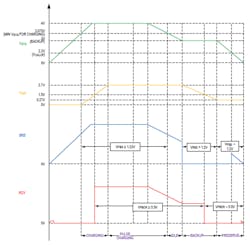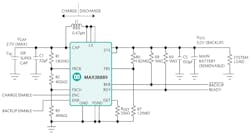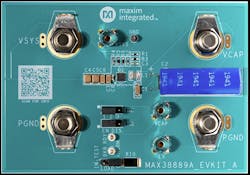Tiny Supercap Regulator Delivers Accuracy, Efficiency
Rechargeable batteries and supercapacitors are widely used as sources of backup power in many applications, with each offering different performance attributes with respect to storage density, number of viable charge/discharge cycles, pulse-power performance, and multiple other factors. If the supercapacitor is the selected backup option, then, as with batteries, they also need management tailored to optimize their performance.
That’s the function of the MAX38889 from Maxim Integrated Products, a reversible buck/boost regulator in its “Continua” family of backup regulators. It operates in buck mode to charge a backup supercapacitor when primary power is available. However, the device switches automatically to boost mode when that power goes away, thus allowing the supercapacitor voltage to power the system until main power is restored (Fig. 1). It also includes 2.5% hysteresis between backup and charging modes to minimize “chattering” and any unwanted system implications of excessive mode switching around the threshold.
In real-world design-ins, a desirable solution is one that not only offers the basic functionality, but also meets challenging size and performance constraints. That’s often the case with power-backup functions, which are squeezed into already tight spaces and must operate quietly for long periods in designs such as smart utility meters, remote sensors, IoT nodes, tracking devices, and automotive dashboard cameras.
According to Maxim, the MAX38889 solution is just one-third the size of competitive solutions (218 mm2 vs. 606 mm2) and has peak efficiency of 94% (9% higher than the closest competitor). It features the tight voltage regulation of 2.5% (often needed by 5-V applications) and ±1% threshold accuracy (Fig. 2).
Peak inductor current is user-programmable over a 1- to 3-A range via an external resistor. Quiescent current, an important factor in these applications, is only 4 μA after the supercapacitor is charged and in its “ready” state. The 16-pin IC, in a 3- × 3-mm TQFN package, is priced at $2.36 (1,000 pieces) and EE-Sim models are available, along with a 17-page datasheet.
Even prospective users of such a basic-function, highly focused IC will likely benefit from availability of an evaluation kit. The MAX38889EVKIT# ($63) is complete and ready to go (Fig. 3). Users need add only a 6-V/4-A dc power supply and two digital multimeters to exercise it (no PC or USB connection is needed). The evaluation kit datasheet includes operating instructions, schematic, bill of materials, and drawings of the board layers.



